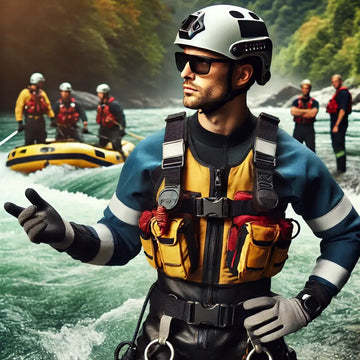Introduction
Water-related emergencies—from boating accidents and flood rescues to submerged vehicle incidents—demand rapid, effective response and robust equipment. As climate change and urban flooding intensify, technological advancements in water rescue are transforming how first responders and emergency teams save lives. In this post, we explore the newest water rescue equipment technologies and trends that are reshaping emergency response on and near water, with a special focus on the innovative JX-6A water rescue drone.
Innovative Water Rescue Vehicles
One of the most notable developments in water rescue technology is the emergence of multifunctional water rescue vehicles. These specialized platforms are engineered to operate seamlessly in both aquatic and terrestrial environments. Key features include:
- Amphibious Capabilities: Modern rescue vehicles can transition between land and water, ensuring rapid deployment even when traditional vehicles cannot access the rescue site.
- Integrated Power and Supply Systems: On-board generators, water pumps, and communication modules support prolonged rescue operations by supplying electricity, water, and compressed air.
- Modular Design: Customizable compartments allow the carriage of essential rescue tools—from inflatable boats to sensor arrays for underwater search and rescue.
A recent article from NetEase highlighted a domestically developed water rescue vehicle that integrates these advanced features into one robust platform, underscoring the importance of integrated design in meeting the complex demands of water rescue scenarios.
Advanced Personal Protective Equipment (PPE)
Rescuer safety is paramount. Advancements in PPE have significantly bolstered water rescue operations. Noteworthy innovations include:
- Smart Life Jackets: These extend beyond traditional buoyancy by incorporating automatic inflation systems and sensors that monitor the wearer’s condition, transmitting real-time data to rescue teams.
- Rescue Helmets with Integrated Communication: Modern helmets offer superior head protection along with built-in communication devices and flotation aids.
- Ergonomically Designed Rescue Gloves and Boots: Enhanced grip, durability, and resistance to harsh aquatic conditions allow rescuers to perform effectively in challenging environments.
Insights from the Zhejiang Life Saving Association reveal that the optimal rescue life jacket now combines buoyancy with mobility through quick-release straps and integrated signaling devices, further enhancing operational safety.
Integration of Smart Technologies and Drones
The future of water rescue is increasingly digital. Cutting-edge trends in this arena include:
- IoT and Real-Time Monitoring: Modern rescue equipment is outfitted with sensors and connectivity modules for real-time tracking of both rescuers and victims, as well as for remote monitoring of water conditions.
- Drone-Assisted Rescue: Unmanned aerial vehicles (UAVs) are revolutionizing water rescue operations. Equipped with high-resolution cameras and thermal imaging, drones can swiftly locate individuals in distress—even in low-visibility conditions—and guide rescue boats or deliver essential supplies.
- Automated Rescue Robots: Experimental underwater rescue robots are being developed to perform search tasks and object retrieval, minimizing risk to human rescuers.
Spotlight on the JX-6A Water Rescue Drone
A standout innovation in the integration of smart technologies is the JX-6A Water Rescue Drone. Developed by DIDIOK MAKINGS, this advanced UAV is designed specifically for water rescue operations. Key attributes include:
- Rapid Deployment: The JX-6A can be deployed within minutes, dramatically reducing the time needed to reach a victim during emergencies.
- Waterproof and Buoyancy Features: With an IP68 waterproof rating, the JX-6A is built to operate in challenging aquatic environments. Its design enables it to remain submerged up to 1.5 meters for one hour while still being capable of takeoff and rescue operations.
- Lightweight and Portable: Weighing approximately 4.38 kg, the drone is highly portable, making it an ideal asset for rescue teams that need to transport multiple pieces of equipment.
- Real-Time Video and Communication: Equipped with a single-axis gimbal camera, the JX-6A provides real-time video feedback to operators, ensuring precise victim location and improved coordination with rescue teams.
- Multi-Functional Role: Dubbed the “flying lifebuoy,” the JX-6A not only locates distressed individuals but can also deliver essential rescue devices—thereby serving as both a surveillance tool and a lifesaving flotation aid.
This drone’s advanced features make it an indispensable tool for coast guards, rescue associations, and emergency management agencies. It epitomizes the trend toward integrated, smart rescue solutions that enhance overall operational efficiency and safety.
Trends and Future Prospects
The landscape of water rescue equipment is evolving along several key directions:
- Increased Integration and Multi-Functionality: The trend is toward creating all-in-one rescue platforms that combine vehicles, personal gear, and smart technologies.
- Enhanced Mobility and Automation: As autonomous systems mature, more unmanned and remotely operated equipment will complement human efforts in high-risk rescue scenarios.
- Sustainability and Durability: Innovations in materials and design improve performance and extend equipment lifespan, ensuring reliability under extreme conditions.
- Standardization and Global Collaboration: Rising international standards (e.g., ISO certifications for lifesaving equipment) promote consistent quality and interoperability among rescue agencies worldwide.
Conclusion
From multifunctional water rescue vehicles and advanced PPE to smart drones like the JX-6A, the latest technological advancements in water rescue equipment are revolutionizing emergency response. These innovations not only safeguard lives but also set new benchmarks for rescue operations across diverse aquatic environments. By integrating the cutting-edge capabilities of the JX-6A water rescue drone, rescue teams can achieve faster, more efficient, and more reliable outcomes in critical situations.
Embrace the future of water rescue—where technology and innovation converge to save lives.





